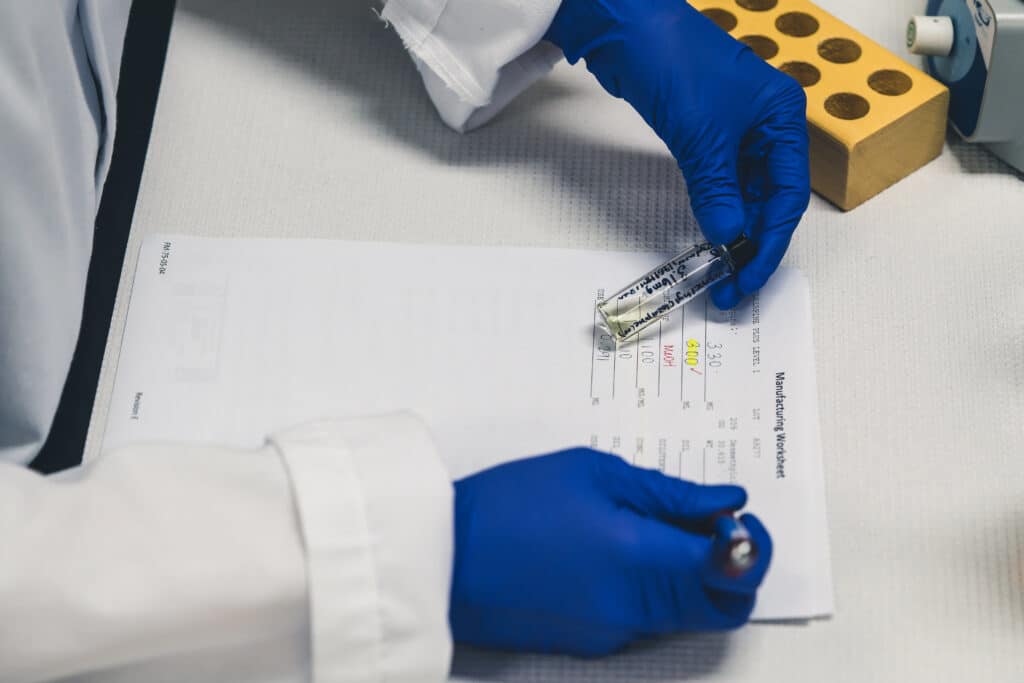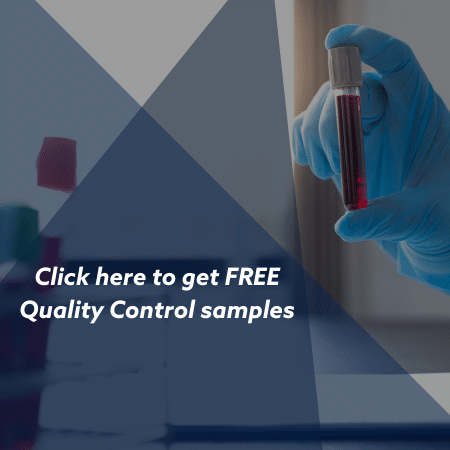
An assay is a laboratory test with two goals:
- Confirm the presence of a suspected substance
- Measure the precise amount of the substance
Effective diagnostic testing relies on two underlying factors: accuracy and precision. If either of these is lacking, the results will not be meaningful. Calibrators and quality controls both have a similar mission: To ensure every assay delivers useful data that can help with decision-making.
However, exactly how they do it differs.
If a laboratory does not make the right use of quality controls and calibrators, its results will be suspect.
What are Calibrators and Quality Controls?
Calibrators and quality controls are important elements of most laboratory work. Calibrators are used to measure the accuracy of test results and often referred to as ‘standardized samples’. Quality controls are used to monitor the performance of testing procedures and are typically used to check the accuracy of test results.
Calibrators consist of materials or devices that have known values, which are used to compare other materials or devices to. This comparison is done to ensure the accuracy of test results. Calibrators are usually used to verify the accuracy of results produced by machines. Quality controls, on the other hand, are used to monitor the performance of laboratory tests and procedures over time.
Quality controls are typically used to check the accuracy of test results and often involve the use of control materials that are similar but not identical to the sample material being tested. The control material is subjected to the same test procedure as the sample material, and any discrepancies between the two results can then be pinpointed. Quality controls can also be used to adjust or improve the accuracy of the test results.
Calibrators and quality controls are important components of laboratory work. Calibrators are used to measure the accuracy of test results and often referred to as ‘standardized samples’. Quality controls are used to monitor the performance of tests and procedures over time, and to adjust or improve the accuracy of test results. By understanding the differences between calibrators and quality controls, laboratory personnel can better ensure the accuracy of their test results.

Did you know that UTAK’s R&D Department often has extra Quality Control samples available? We believe these additional samples can be valuable for intern projects, senior projects, instructional for instrumentation labs, and academic research projects.
You can submit a request for samples here.
Comparing Calibrators and Quality Controls
Calibrators and Quality Controls are two terms that are often used interchangeably, but they are not the same. Calibrators are tools used to adjust and measure the accuracy of test results obtained from measuring instruments. Quality controls are samples of material used to monitor and adjust a laboratory’s performance. Calibrators and Quality Controls (QCs) are two indispensable components of any laboratory. While their roles and objectives are closely related, there are important differences that must be considered when integrating them into a laboratory’s workflow.
Calibrators are used to measure the accuracy of an analytical system. They are used to adjust or “calibrate” the system’s analytical performance by quantifying the deviation of the results from the expected values. Calibrators are usually composed of solutions that contain known concentrations of analytes, which are used to adjust the analytical system to a certain level of accuracy.
QCs, on the other hand, are used to monitor the system’s performance over time. They are used to detect any drift or change in the system’s performance, which can lead to inaccurate results. QCs also help identify any changes in the system’s chemistry or environment, which can have an adverse effect on the results. QCs are usually composed of solutions that contain a variety of analytes and are used to assess the accuracy and precision of the analytical system.
Benefits of Using Calibrators
Calibrators are essential tools for many industries, particularly those that rely on accurate measurements and analysis. Calibrators can also be used to fine-tune instruments, ensuring that they are as accurate as possible.
Calibrators Establish a Baseline of Reproducibility
Accuracy and precision are the two key performance indicators of any clinical laboratory testing regime. Precision refers to the ability to reproduce a result. If a specimen is tested for potassium ten times, for example, we want to see the same result each time.
Before accuracy can be assessed, precision must already be in place. Producing the same result across a variety of values is the function of the calibrators. The calibrator enables you to adjust your systems, so they match the established reference system or standard most relevant to your work.
Quality Control Is Key for Accuracy
When reproducibility has been verified, accuracy is the next area of focus. Effective assays must be very accurate: When you are testing down to the thousandth decimal place, precision and accuracy make the difference between indigestion and a myocardial infarction.
After calibration is complete, quality controls are introduced to ensure laboratory tests get as close to the “true” value of each assay as possible. The true value of an assay, of course, is the factually accurate presence and amount of a substance within a specimen.
Quality controls provide a range of acceptable results. The true result is represented by the mean value. By running this known value through your testing regime, you can discover whether or not your current methodology is accurate. This also clarifies the appropriate changes to make to raise your accuracy.
UTAK Provides High Quality Toxicology Controls for the Modern Lab Environment
UTAK’s product catalog encompasses rigorous quality control products including 100% REAL urine, 100% REAL human blood, and specialty matrices such as hair, oral fluid, serum, spinal fluid, and sweat. We are “Control Freaks” glad to uphold the highest standards. We even offer fully personalized QC solutions, and have been making custom QC since 1973.
Connect with a Control Freak today to learn more about how QC and calibrators differ.
